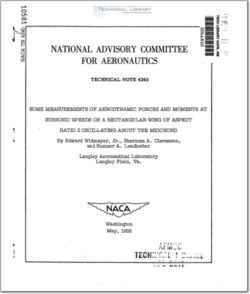NACA-TN-4240

- Version
- 196 Downloads
- 1.45 MB File Size
- 1 File Count
- December 4, 2015 Create Date
- December 4, 2015 Last Updated
National Advisory Committee for Aeronautics, Technical Notes - Some Measurements of Aerodynamic Force and Moments at Subsonic Speeds on a Rectangular Wing of Aspect Ratio 2 Oscillating about the Mid-chord

Some measurements were made of the aerodynamic forces and moments
acting on a rectangular wing of aspect ratio 2 which was oscillated about
the midchord. These measurements were made at four frequencies (51, 11-5,
5k, and 62 cps) over a range of Mach number from 0.15 to 0.81, a range of
reduced frequency from 0.15 to 1.52, and a range of Reynolds number from
0.60 x 106 to 9.21 x 106. It was feasible to compare results of a por-
tion of these measurements with some published experimental data and, in
general, reasonable agreement was found to exist. An appendix is included
to show the correction of the root reaction for inertia and aerodynamic
effects in order to determine the total aerodynamic load.
Comparison of the measured aerodynamic forces and moments with those
predicted by the method of Reissner and by the method of Lawrence and
Gerber for wings of aspect ratio 2 in incompressible flow showed generally
good agreement. Comparison of the measured quantities with those predicted
by two-dimensional-flow theory indicated that the effects of finiteness of
span on the aerodynamic forces and moments are considerable. Some experi-
mental results pertaining to the influence of wind-tunnel-wall effects on
nonsteady aerodynamic measurement have been included.
A need exists-for experimental measurements of oscillating air forces
because of the significance of these forces in flutter and related fields,
and in order to assess past and present theoretical work. Despite the
importance of the problem, only a limited amount of data, both experimental
and theoretical, exists for restricted ranges of aspect ratio, Mach
number, and Reynolds number.
Theoretical treatment of aspect—ratio effects on the oscillatory
aerodynamic coefficients for subsonic speeds is in a state of develop—
ment and is not yet in a form convenient for numerical comparison.
There is difficulty in mathematically representing the physical phenomena
and certain assumptions necessary to obtain a solution are doubtful, par-
ticularly those associated with tip effects. Consequently, current
experimental measurements will be compared With readily available experi—
mental and theoretical oscillatory coefficients.
| File | Action |
|---|---|
| naca-tn-4240.pdf | Download |

Comment On This Post